Retail Furniture Manufacturer Business Plan
The furniture industry is worth $12 billion, with a primary focus on affluent customers willing to spend up to $3,000 on furniture. In Richmond, there are fifteen furniture stores vying for these customers with deep pockets. Unfortunately, those who cannot afford these high prices are left with a limited selection of subpar products.
Meanwhile, in the Richmond Metro area, approximately 50,000 residents with modest incomes lack a furniture store that caters to their need for affordable, quality furniture. Over the past five years, this income demographic has grown significantly, yet local furniture stores have failed to respond. Targeting customers with modest incomes is a lucrative business opportunity, as they are projected to make up half of the metro population by 2020, becoming the fastest-growing segment in the city’s housing market.
Currently, there are three modest-income housing renovation projects in progress in Richmond, totaling 1,500 units that will be sold as affordable housing.
In the midst of Richmond Metro’s revival, The House of Pine plans to offer customized, ready-to-finish pine furniture that is both handmade and surprisingly affordable. Our offerings include:
- Truly Custom Furniture: Crafted specifically for each customer, we can customize any piece or create a new one based on a rough sketch provided by the customer.
- Heirloom Quality Furniture: Our furniture is designed to last for generations, as it is meticulously crafted by hand, resulting in a unique piece every time.
- Handmade from Quality Pine: Our skilled craftsmen create each piece using only the finest available pine. Before production, every piece of pine is carefully inspected for grain and texture.
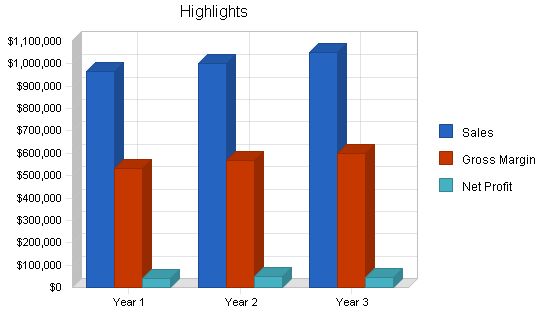
The House of Pine has a simple mission: to provide customers with furniture that fits their space, taste, budget, and style preference, whether it’s one piece or a whole house full.
The keys to success for The House of Pine are:
– Offering customers affordable quality furniture that will last.
– Customizing any piece as requested by a customer.
– Creating a whole new piece from scratch if customizing won’t work.
The company summary:
The House of Pine offers customized, ready-to-finish pine furniture that’s handcrafted and surprisingly affordable. It targets young families and young adults with modest incomes who want high-end selection and quality. Each piece is built from fine pine and designed to last for generations.
Company ownership:
Richard Putnam owns The House of Pine and has over 10 years of furniture manufacturing experience.
Company locations and facilities:
The House of Pine is centrally located in the industrial section of the Richmond Metro area.
Start-up summary:
The start-up costs for The House of Pine mainly consist of furniture manufacturing equipment and transport containers. Richard Putnam will invest $50,000 and secure a $130,000 loan.
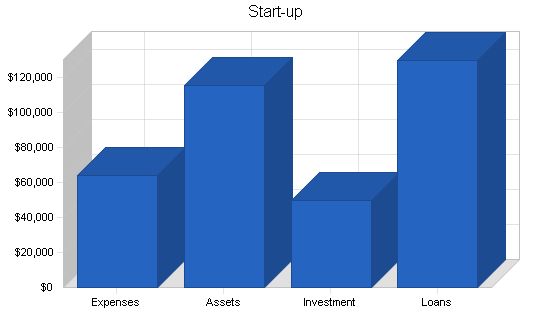
Start-up Requirements
Start-up Expenses
Legal – $1,000
Stationery etc. – $200
Insurance – $1,000
Rent – $2,000
Expensed Equipment – $60,000
Total Start-up Expenses – $64,200
Start-up Assets
Cash Required – $5,800
Start-up Inventory – $50,000
Other Current Assets – $0
Long-term Assets – $60,000
Total Assets – $115,800
Total Requirements – $180,000
Start-up Funding
Start-up Expenses to Fund – $64,200
Start-up Assets to Fund – $115,800
Total Funding Required – $180,000
Assets
Non-cash Assets from Start-up – $110,000
Cash Requirements from Start-up – $5,800
Additional Cash Raised – $0
Cash Balance on Starting Date – $5,800
Total Assets – $115,800
Liabilities and Capital
Liabilities
Current Borrowing – $0
Long-term Liabilities – $130,000
Accounts Payable (Outstanding Bills) – $0
Other Current Liabilities (interest-free) – $0
Total Liabilities – $130,000
Capital
Planned Investment
Richard Putnam – $50,000
Other – $0
Additional Investment Requirement – $0
Total Planned Investment – $50,000
Loss at Start-up (Start-up Expenses) – ($64,200)
Total Capital – ($14,200)
Total Capital and Liabilities – $115,800
Total Funding – $180,000
Products and Services
The House of Pine will offer wood products for the bedroom, living and dining room, and the storage room:
– Beds
– Dressers
– Chests
– Armoires
– Entertainment centers
– Bookcases
– Tables
– Chairs
– Benches
Market Analysis Summary
In the Richmond Metro area, there are approximately 50,000 residents with modest incomes. They are expected to make up half of the metro population by 2020, making them the fastest-growing segment of the city’s housing market.
It is estimated that the Richmond Metro area will need 10,000 units of affordable housing in the next seven years. Currently, there are three renovation projects that represent 1,500 new housing units. Next year, two new construction projects will be completed, offering another 1,000 units of affordable housing. Another 1,000 unit project, to be located in the Garden Meadows section downtown, is currently in the planning stages.
There are changes occurring around the State University, located downtown, that will also impact the revival of the Richmond Metro area. Two off-campus housing projects will be completed mid-year, adding an additional 2,000 family housing units to the university area.
Market Segmentation
The growth of affordable housing in the Richmond Metro area is critical to the success of The House of Pine.
We will aggressively market our target customers who live in the Metro area:
– Young working families
– Students
– Young adults
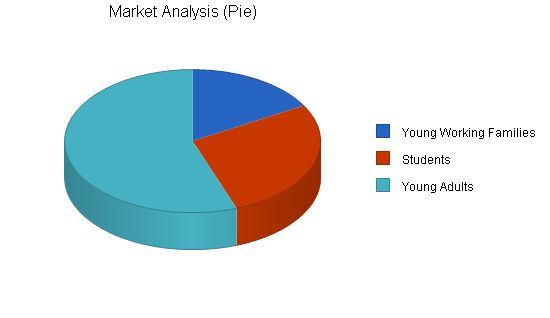
Market Analysis
Year 1 Year 2 Year 3 Year 4 Year 5
Potential Customers Growth CAGR
Young Working Families 12% 3,000 3,360 3,763 4,215 4,721 12.00%
Students 10% 5,000 5,500 6,050 6,655 7,321 10.00%
Young Adults 10% 10,000 11,000 12,100 13,310 14,641 10.00%
Total 10.34% 18,000 19,860 21,913 24,180 26,683 10.34%
Strategy and Implementation Summary
The House of Pine will focus on the modest income furniture customer in the Richmond Metro area.
5.1 Competitive Edge
Most of Richmond’s fifteen furniture stores are dispersed throughout the city adjacent to affluent or suburban communities. The downtown stores are high-end and offer no affordable products to the Metro residents.
The primary reason for the price of the furniture is the type of wood used. A bedroom set made of pine can cost a customer $400, while the same set made in oak or maple will cost $800. Focusing on the more expensive wood yields higher profits. However, many manufacturers cut costs and sacrifice quality when using pine, thus creating a popular misconception that pine is an inferior wood.
The Richmond furniture stores offer a limited selection of pine styles, with most products chosen for maximum store profit rather than customer satisfaction.
The House of Pine will prioritize longevity in the furniture it builds and provide customers with a wide selection of popular styles.
To develop effective business strategies, perform a SWOT analysis of your business. Our free guide and template make conducting a SWOT analysis easy. Learn how to perform a SWOT analysis.
5.2 Sales Strategy
We will advertise in the university’s daily student newspaper and the Metro area advertising flyer. For the store opening, we will offer a 20% off coupon, which will continue for the first month of operation.
The Metro area also has six community organizations that distribute weekly flyers to all residents. We will advertise in these flyers.
5.2.1 Sales Forecast
The following is the sales forecast for the next three years.
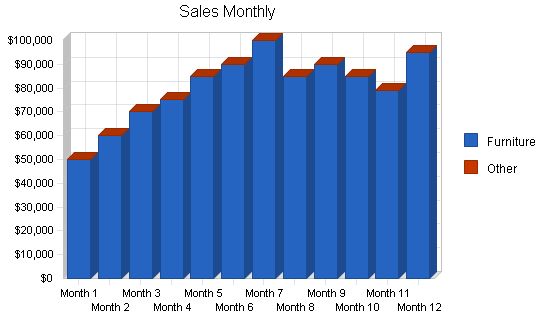
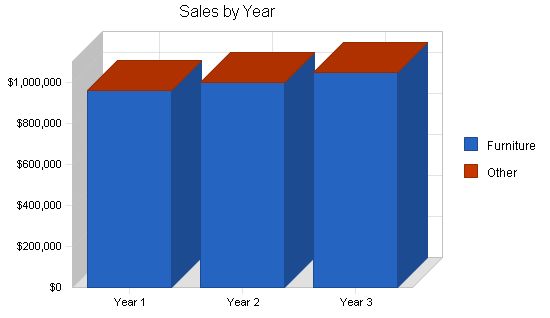
Sales Forecast
Year 1 Year 2 Year 3
Sales
Furniture $964,000 $1,000,000 $1,050,000
Other $0 $0 $0
Total Sales $964,000 $1,000,000 $1,050,000
Direct Cost of Sales
Year 1 Year 2 Year 3
Furniture $432,000 $430,000 $450,000
Other $0 $0 $0
Subtotal Direct Cost of Sales $432,000 $430,000 $450,000
Management Summary
The store’s owner, Richard Putnam, has over ten years of experience in the furniture manufacturing industry. He worked at Ingram’s Fine Furniture for five years, reaching the position of shift manager within three years. Richard was most recently the operations manager at Wasserman Furniture Manufacturing.
Richard is an excellent staff supervisor and will effectively manage the staff of The House of Pine.
Personnel Plan
The House of Pine will have the following staff members:
– Manager
– Assistant manager
– Office manager/accountant
– Checkers (1.5)
– Production staff (5)
– Stockers (1.5)
Year 1 Year 2 Year 3
Manager $36,000 $40,000 $45,000
Assistant Manager $36,000 $39,000 $43,000
Office Manager/Bookkeeper$36,000 $39,000 $42,000
Checkers $32,400 $35,500 $40,000
Production Staff $120,000 $130,000 $140,000
Stockers $39,600 $43,000 $46,000
Total People 9 9 9
Total Payroll $300,000 $326,500 $356,000
The following is the financial plan for The House of Pine.
The following table and chart show our monthly sales break-even point.
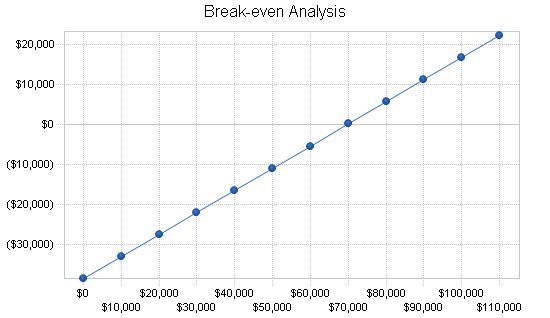
Break-even Analysis
Monthly Revenue Break-even: $69,767
Assumptions:
– Average Percent Variable Cost: 45%
– Estimated Monthly Fixed Cost: $38,502
7.2 Projected Profit and Loss
The table and charts below illustrate the projected profit and loss for three years.
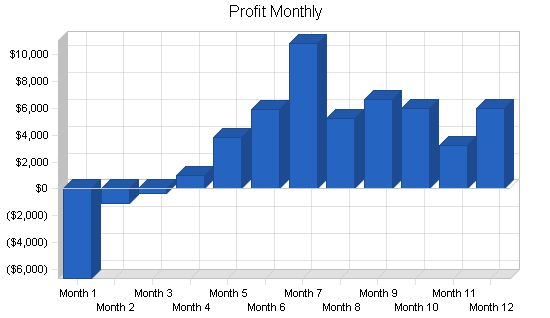
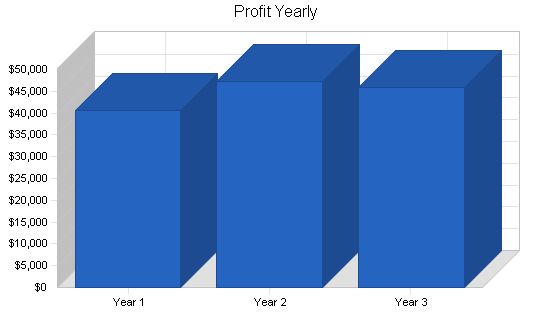
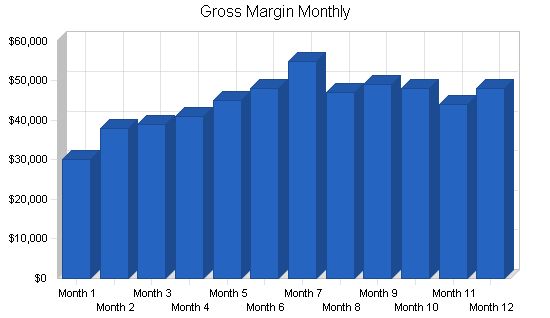
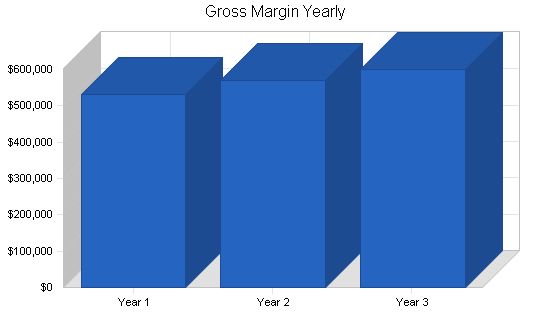
Pro Forma Profit and Loss
Year 1 Year 2 Year 3
Sales $964,000 $1,000,000 $1,050,000
Direct Cost of Sales $432,000 $430,000 $450,000
Other Production Expenses $0 $0 $0
Total Cost of Sales $432,000 $430,000 $450,000
Gross Margin $532,000 $570,000 $600,000
Gross Margin % 55.19% 57.00% 57.14%
Expenses
Payroll $300,000 $326,500 $356,000
Sales and Marketing and Other Expenses $60,000 $60,000 $60,000
Depreciation $11,424 $11,424 $11,424
Leased Equipment $0 $0 $0
Utilities $9,600 $9,600 $9,600
Insurance $12,000 $12,000 $12,000
Rent $24,000 $24,000 $24,000
Payroll Taxes $45,000 $48,975 $53,400
Other $0 $0 $0
Total Operating Expenses $462,024 $492,499 $526,424
Profit Before Interest and Taxes $69,976 $77,501 $73,576
EBITDA $81,400 $88,925 $85,000
Interest Expense $11,917 $10,001 $8,002
Taxes Incurred $17,418 $20,250 $19,672
Net Profit $40,641 $47,250 $45,902
Net Profit/Sales 4.22% 4.72% 4.37%
7.3 Projected Cash Flow
The table and chart below illustrate the projected cash flow for three years.
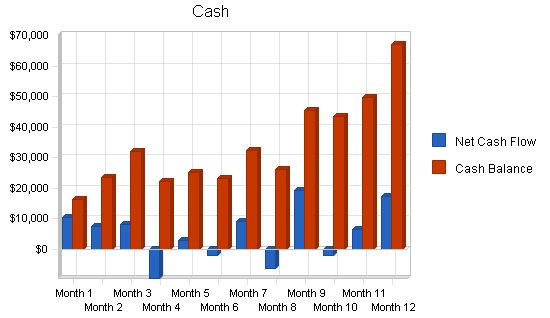
Pro Forma Cash Flow
Year 1 Year 2 Year 3
Cash Received
Cash from Operations
Cash Sales $723,000 $750,000 $787,500
Cash from Receivables $198,158 $248,400 $260,278
Subtotal Cash from Operations $921,158 $998,400 $1,047,778
Additional Cash Received
Sales Tax, VAT, HST/GST Received $0 $0 $0
New Current Borrowing $0 $0 $0
New Other Liabilities (interest-free) $0 $0 $0
New Long-term Liabilities $0 $0 $0
Sales of Other Current Assets $0 $0 $0
Sales of Long-term Assets $0 $0 $0
New Investment Received $0 $0 $0
Subtotal Cash Received $921,158 $998,400 $1,047,778
Expenditures
Year 1 Year 2 Year 3
Expenditures from Operations
Cash Spending $300,000 $326,500 $356,000
Bill Payments $539,935 $637,773 $637,056
Subtotal Spent on Operations $839,935 $964,273 $993,056
Additional Cash Spent
Sales Tax, VAT, HST/GST Paid Out $0 $0 $0
Principal Repayment of Current Borrowing $0 $0 $0
Other Liabilities Principal Repayment $0 $0 $0
Long-term Liabilities Principal Repayment $19,992 $19,992 $19,992
Purchase Other Current Assets $0 $0 $0
Purchase Long-term Assets $0 $0 $0
Dividends $0 $0 $0
Subtotal Cash Spent $859,927 $984,265 $1,013,048
Net Cash Flow $61,231 $14,136 $34,730
Cash Balance $67,031 $81,167 $115,897
Projected Balance Sheet
Year 1 Year 2 Year 3
Assets
Current Assets
Cash $67,031 $81,167 $115,897
Accounts Receivable $42,842 $44,442 $46,664
Inventory $51,700 $51,461 $53,854
Other Current Assets $0 $0 $0
Total Current Assets $161,573 $177,069 $216,415
Long-term Assets
Long-term Assets $60,000 $60,000 $60,000
Accumulated Depreciation $11,424 $22,848 $34,272
Total Long-term Assets $48,576 $37,152 $25,728
Total Assets $210,149 $214,221 $242,143
Liabilities and Capital
Year 1 Year 2 Year 3
Current Liabilities
Accounts Payable $73,700 $50,514 $52,526
Current Borrowing $0 $0 $0
Other Current Liabilities $0 $0 $0
Subtotal Current Liabilities $73,700 $50,514 $52,526
Long-term Liabilities $110,008 $90,016 $70,024
Total Liabilities $183,708 $140,530 $122,550
Paid-in Capital $50,000 $50,000 $50,000
Retained Earnings ($64,200) ($23,559) $23,691
Earnings $40,641 $47,250 $45,902
Total Capital $26,441 $73,691 $119,593
Total Liabilities and Capital $210,149 $214,221 $242,143
Sales Growth – starts below industry average but aligns with average after the third year of operation.
Accounts Receivable – below average due to low use of credit for purchases (25%).
Inventory – below industry average due to 20% of furniture being built to order.
Long Term Assets, Long Term Liabilities, and Expense of Sales – higher due to on-site furniture building.
Ratio Analysis
Year 1 Year 2 Year 3 Industry Profile
Sales Growth 0.00% 3.73% 5.00% 6.20%
Percent of Total Assets
Accounts Receivable 20.39% 20.75% 19.27% 21.00%
Inventory 24.60% 24.02% 22.24% 38.80%
Other Current Assets 0.00% 0.00% 0.00% 21.70%
Total Current Assets 76.88% 82.66% 89.37% 81.50%
Long-term Assets 23.12% 17.34% 10.63% 18.50%
Total Assets 100.00% 100.00% 100.00% 100.00%
Current Liabilities
Accounts Payable 35.07% 23.58% 21.69% 44.90%
Long-term Liabilities 52.35% 42.02% 28.92% 13.70%
Total Liabilities 87.42% 65.60% 50.61% 58.60%
Net Worth 12.58% 34.40% 49.39% 41.40%
Percent of Sales
Sales 100.00% 100.00% 100.00% 100.00%
Gross Margin 55.19% 57.00% 57.14% 37.60%
Selling, General & Administrative Expenses 50.97% 52.28% 52.77% 20.80%
Advertising Expenses 6.22% 6.00% 5.71% 4.40%
Profit Before Interest and Taxes 7.26% 7.75% 7.01% 1.60%
Main Ratios
Current 2.19 3.51 4.12 1.82
Quick 1.49 2.49 3.09 0.76
Total Debt to Total Assets 87.42% 65.60% 50.61% 58.60%
Pre-tax Return on Net Worth 219.58% 91.60% 54.83% 3.80%
Pre-tax Return on Assets 27.63% 31.51% 27.08% 9.20%
Additional Ratios
Net Profit Margin 4.22% 4.72% 4.37% n.a
Return on Equity 153.70% 64.12% 38.38% n.a
Activity Ratios
Accounts Receivable Turnover 5.63 5.63 5.63 n.a
Collection Days 57 64 63 n.a
Inventory Turnover 10.73 8.34 8.55 n.a
Accounts Payable Turnover 8.33 12.17 12.17 n.a
Payment Days 27 37 29 n.a
Total Asset Turnover 4.59 4.67 4.34 n.a
Debt Ratios
Debt to Net Worth 6.95 1.91 1.02 n.a
Current Liab. to Liab. 0.40 0.36 0.43 n.a
Liquidity Ratios
Net Working Capital $87,873 $126,555 $163,889 n.a
Interest Coverage 5.87 7.75 9.19 n.a
Additional Ratios
Assets to Sales 0.22 0.21 0.23 n.a
Current Debt/Total Assets 35% 24% 22% n.a
Acid Test 0.91 1.61 2.21 n.a
Sales/Net Worth 36.46 13.57 8.78 n.a
Dividend Payout 0.00 0.00 0.00 n.a
Appendix
Sales Forecast
Month 1 Month 2 Month 3 Month 4 Month 5 Month 6 Month 7 Month 8 Month 9 Month 10 Month 11 Month 12
Sales
Furniture $50,000 $60,000 $70,000 $75,000 $85,000 $90,000 $100,000 $85,000 $90,000 $85,000 $79,000 $95,000
Other $0 $0 $0 $0 $0 $0 $0 $0 $0 $0 $0 $0
Total Sales $50,000 $60,000 $70,000 $75,000 $85,000 $90,000 $100,000 $85,000 $90,000 $85,000 $79,000 $95,000
Direct Cost of Sales
Month 1 Month 2 Month 3 Month 4 Month 5 Month 6 Month 7 Month 8 Month 9 Month 10 Month 11 Month 12
Furniture $20,000 $22,000 $31,000 $34,000 $40,000 $42,000 $45,000 $38,000 $41,000 $37,000 $35,000 $47,000
Other $0 $0 $0 $0 $0 $0 $0 $0 $0 $0 $0 $0
Subtotal Direct Cost of Sales $20,000 $22,000 $31,000 $34,000 $40,000 $42,000 $45,000 $38,000 $41,000 $37,000 $35,000 $47,000
Personnel Plan:
Manager: 0%, $3,000 per month for months 1-12
Assistant Manager: 0%, $3,000 per month for months 1-12
Office Manager/Bookkeeper: 0%, $3,000 per month for months 1-12
Checkers: 0%, $2,700 per month for months 1-12
Production Staff: 0%, $10,000 per month for months 1-12
Stockers: 0%, $3,300 per month for months 1-12
Total People: 9 for months 1-12
Total Payroll: $25,000 per month for months 1-12
General Assumptions:
Plan Month: 1-12
Current Interest Rate: 10.00% for months 1-12
Long-term Interest Rate: 10.00% for months 1-12
Tax Rate: 30.00% for months 1-12
Other: 0 for months 1-12
Pro Forma Profit and Loss:
Sales: $50,000 for month 1, $60,000 for month 2, $70,000 for month 3,$75,000 for month 4, $85,000 for month 5,
$90,000 for month 6, $100,000 for month 7,$85,000 for month 8, $90,000 for month 9, $85,000 for month 10,
$79,000 for month 11, $95,000 for month 12
Direct Cost of Sales: $20,000 for month 1, $22,000 for month 2, $31,000 for month 3, $34,000 for month 4, $40,000 for month 5,
$42,000 for month 6, $45,000 for month 7, $38,000 for month 8, $41,000 for month 9, $37,000 for month 10,
$35,000 for month 11, $47,000 for month 12
Other Production Expenses: $0 for months 1-12
Total Cost of Sales: $20,000 for month 1, $22,000 for month 2, $31,000 for month 3, $34,000 for month 4, $40,000 for month 5,
$42,000 for month 6, $45,000 for month 7, $38,000 for month 8, $41,000 for month 9, $37,000 for month 10,
$35,000 for month 11, $47,000 for month 12
Gross Margin: $30,000 for month 1, $38,000 for month 2, $39,000 for month 3, $41,000 for month 4, $45,000 for month 5,
$48,000 for month 6, $55,000 for month 7, $47,000 for month 8, $49,000 for month 9, $48,000 for month 10,
$44,000 for month 11, $48,000 for month 12
Gross Margin %: 60.00% for month 1, 63.33% for month 2, 55.71% for month 3, 54.67% for month 4, 52.94% for month 5,
53.33% for month 6, 55.00% for month 7, 55.29% for month 8, 54.44% for month 9, 56.47% for month 10,
55.70% for month 11, 50.53% for month 12
Expenses:
Payroll: $25,000 for months 1-12
Sales and Marketing and Other Expenses: $5,000 for months 1-12
Depreciation: $952 for months 1-12
Leased Equipment: $0 for months 1-12
Utilities: $800 for months 1-12
Insurance: $1,000 for months 1-12
Rent: $2,000 for months 1-12
Payroll Taxes: 15% for months 1-12
Other: $0 for months 1-12
Total Operating Expenses: $38,502 for months 1-12
Profit Before Interest and Taxes: ($8,502) for month 1, ($502) for month 2, $498 for month 3, $2,498 for month 4, $6,498 for month 5,
$9,498 for month 6, $16,498 for month 7, $8,498 for month 8, $10,498 for month 9, $9,498 for month 10,
$5,498 for month 11, $9,498 for month 12
EBITDA: ($7,550) for month 1, $450 for month 2, $1,450 for month 3, $3,450 for month 4, $7,450 for month 5,
$10,450 for month 6, $17,450 for month 7, $9,450 for month 8, $11,450 for month 9, $10,450 for month 10,
$6,450 for month 11, $10,450 for month 12
Interest Expense: $1,069 for month 1, $1,056 for month 2, $1,042 for month 3, $1,028 for month 4, $1,014 for month 5,
$1,000 for month 6, $986 for month 7, $972 for month 8, $958 for month 9, $945 for month 10,
$931 for month 11, $917 for month 12
Taxes Incurred: ($2,871) for month 1, ($467) for month 2, ($163) for month 3, $441 for month 4, $1,645 for month 5,
$2,549 for month 6, $4,654 for month 7, $2,258 for month 8, $2,862 for month 9, $2,566 for month 10,
$1,370 for month 11, $2,574 for month 12
Net Profit: ($6,700) for month 1, ($1,090) for month 2, ($381) for month 3, $1,029 for month 4, $3,839 for month 5,
$5,949 for month 6, $10,858 for month 7, $5,268 for month 8, $6,678 for month 9, $5,987 for month 10,
$3,197 for month 11, $6,007 for month 12
Net Profit/Sales: -13.40% for month 1, -1.82% for month 2, -0.54% for month 3, 1.37% for month 4, 4.52% for month 5,
6.61% for month 6, 10.86% for month 7, 6.20% for month 8, 7.42% for month 9, 7.04% for month 10,
4.05% for month 11, 6.32% for month 12
Pro Forma Cash Flow
Pro Forma Cash Flow is a table that showcases the cash received and expenditures over a period of twelve months. It provides valuable insights into the financial health of a business.
Cash Received
Cash Sales:
Month 1: $37,500
Month 2: $45,000
Month 3: $52,500
Month 4: $56,250
Month 5: $63,750
Month 6: $67,500
Month 7: $75,000
Month 8: $63,750
Month 9: $67,500
Month 10: $63,750
Month 11: $59,250
Month 12: $71,250
Cash from Receivables:
Month 1: $0
Month 2: $417
Month 3: $12,583
Month 4: $15,083
Month 5: $17,542
Month 6: $18,833
Month 7: $21,292
Month 8: $22,583
Month 9: $24,875
Month 10: $21,292
Month 11: $22,458
Month 12: $21,200
Subtotal Cash from Operations:
Month 1: $37,500
Month 2: $45,417
Month 3: $65,083
Month 4: $71,333
Month 5: $81,292
Month 6: $86,333
Month 7: $96,292
Month 8: $86,333
Month 9: $92,375
Month 10: $85,042
Month 11: $81,708
Month 12: $92,450
Expenditures
Expenditures from Operations:
Cash Spending:
Month 1: $25,000
Month 2: $25,000
Month 3: $25,000
Month 4: $25,000
Month 5: $25,000
Month 6: $25,000
Month 7: $25,000
Month 8: $25,000
Month 9: $25,000
Month 10: $25,000
Month 11: $25,000
Month 12: $25,000
Bill Payments:
Month 1: $358
Month 2: $11,368
Month 3: $30,171
Month 4: $54,228
Month 5: $51,669
Month 6: $61,759
Month 7: $60,506
Month 8: $65,809
Month 9: $46,566
Month 10: $60,270
Month 11: $48,627
Month 12: $48,604
Subtotal Spent on Operations:
Month 1: $25,358
Month 2: $36,368
Month 3: $55,171
Month 4: $79,228
Month 5: $76,669
Month 6: $86,759
Month 7: $85,506
Month 8: $90,809
Month 9: $71,566
Month 10: $85,270
Month 11: $73,627
Month 12: $73,604
Additional Cash Spent:
Sales Tax, VAT, HST/GST Paid Out:
Month 1: $0
Month 2: $0
Month 3: $0
Month 4: $0
Month 5: $0
Month 6: $0
Month 7: $0
Month 8: $0
Month 9: $0
Month 10: $0
Month 11: $0
Month 12: $0
Principal Repayment of Current Borrowing:
Month 1: $0
Month 2: $0
Month 3: $0
Month 4: $0
Month 5: $0
Month 6: $0
Month 7: $0
Month 8: $0
Month 9: $0
Month 10: $0
Month 11: $0
Month 12: $0
Other Liabilities Principal Repayment:
Month 1: $0
Month 2: $0
Month 3: $0
Month 4: $0
Month 5: $0
Month 6: $0
Month 7: $0
Month 8: $0
Month 9: $0
Month 10: $0
Month 11: $0
Month 12: $0
Long-term Liabilities Principal Repayment:
Month 1: $1,666
Month 2: $1,666
Month 3: $1,666
Month 4: $1,666
Month 5: $1,666
Month 6: $1,666
Month 7: $1,666
Month 8: $1,666
Month 9: $1,666
Month 10: $1,666
Month 11: $1,666
Month 12: $1,666
Purchase Other Current Assets:
Month 1: $0
Month 2: $0
Month 3: $0
Month 4: $0
Month 5: $0
Month 6: $0
Month 7: $0
Month 8: $0
Month 9: $0
Month 10: $0
Month 11: $0
Month 12: $0
Purchase Long-term Assets:
Month 1: $0
Month 2: $0
Month 3: $0
Month 4: $0
Month 5: $0
Month 6: $0
Month 7: $0
Month 8: $0
Month 9: $0
Month 10: $0
Month 11: $0
Month 12: $0
Dividends:
Month 1: $0
Month 2: $0
Month 3: $0
Month 4: $0
Month 5: $0
Month 6: $0
Month 7: $0
Month 8: $0
Month 9: $0
Month 10: $0
Month 11: $0
Month 12: $0
Subtotal Cash Spent:
Month 1: $27,024
Month 2: $38,034
Month 3: $56,837
Month 4: $80,894
Month 5: $78,335
Month 6: $88,425
Month 7: $87,172
Month 8: $92,475
Month 9: $73,232
Month 10: $86,936
Month 11: $75,293
Month 12: $75,270
Net Cash Flow:
Month 1: $10,476
Month 2: $7,383
Month 3: $8,246
Month 4: ($9,561)
Month 5: $2,957
Month 6: ($2,091)
Month 7: $9,120
Month 8: ($6,142)
Month 9: $19,143
Month 10: ($1,894)
Month 11: $6,415
Month 12: $17,180
Cash Balance:
Month 1: $16,276
Month 2: $23,659
Month 3: $31,905
Month 4: $22,344
Month 5: $25,301
Month 6: $23,209
Month 7: $32,329
Month 8: $26,187
Month 9: $45,330
Month 10: $43,436
Month 11: $49,851
Month 12: $67,031
Hello!
I’m Andrew Brooks, a seasoned finance consultant from the USA and the mind behind phonenumber247.com.
My career is built on a foundation of helping individuals and businesses thrive financially in an ever-changing economic landscape. At phonenumber247.com, my aim is to demystify the complex world of finance, providing clear, actionable advice that can help you navigate your financial journey with confidence. Whether it’s personal finance management, investment strategies, or understanding the nuances of market dynamics, I’m here to share insights and tools that can propel you towards your financial goals.
Welcome to my digital space, where every piece of advice is a step closer to financial clarity and success!
